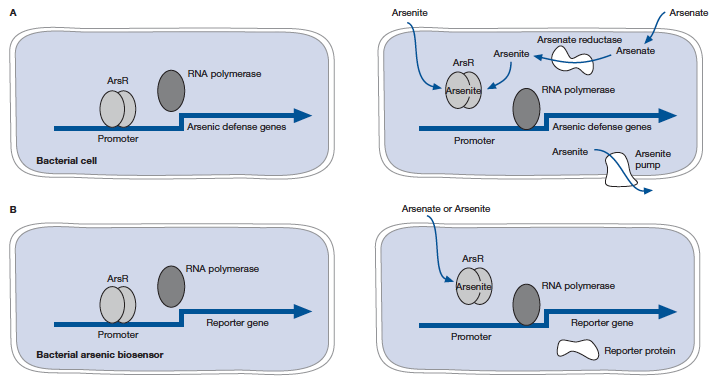- français
- English
One word about GMO
Our prototype uses GMO bacteria for arsenic detection. The detection of Arsenic by fluorescence was inspired of the defense mechanisms of bacteria against Arsenic. Because of recent research, we know that bacteria like E.Coli have two mechanisms of defense:
- An arsenic pump which expulses the arsenic from the cell.
- An arsenate reductase which reduces arsenate in arsenite.
ArsR is a repressor of the arsenic defense genes coding for arsenite pumps and arsenate reductase. It acts as a detector of Arsenic. Indeed when arsenic is present, ArsR loses its affinity to the promoter thus leading to the transcription of the genes. So the idea was to express GFP instead of these defense mechanisms.
This diagram illustrates this:

To make these GMO, we used a specific laboratory bacteria strain called K-12 E. coli DH5α, which isn’t pathogenic, has a very low survival rate in the environment and that cannot do conjugation (i.e. transfer of genetic material between bacterial cells). The plasmid has a resistance to Kanamycin for easy selection during growth of the bacteria.
But what happens if the GMO are released in the field?
Well, not much actually. If they are still alive, they won’t be able to transfer their plasmid by itself to other bacteria as they cannot do conjugation. Thus no genetic material would be transferred. If the cells die and lyse, we could imagine that the plasmid DNA could be liberated and theoretically be taken up by naturally transformable strains. However, this usually only happens in case of selective pressure; which isn’t the case in the environment. Also, GFP is nontoxic and isn’t dangerous. Concerning Kanamycin resistance, lots of other antibacterial drugs exist to treat bacteria if needed. This resistance could be removed; however we’d lose a lot of efficiency in our measurements.
Due to the GMO character of our bacteria , the question of their confinement was very important and this is why we use a special vial to avoid contamination.
- Ce wiki
- Cette page
